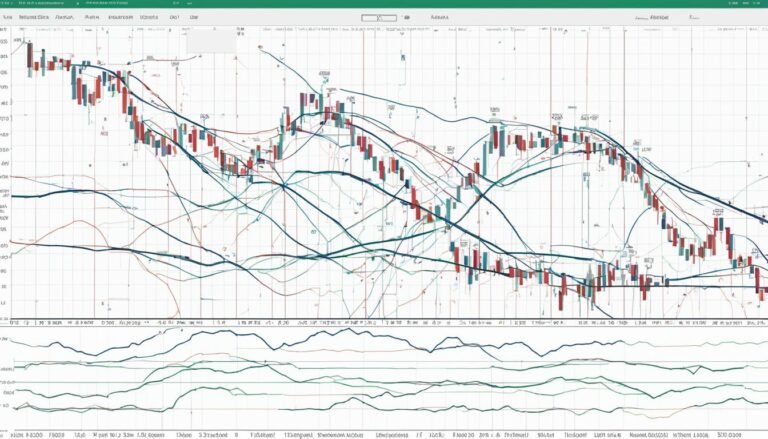Quantitative Portfolio Construction
In the domain of investment management, you often face the dichotomy of intuition versus data-driven decisions when constructing your portfolio. By harnessing the power of quantitative methods, you can systematically analyze vast amounts of financial data to make informed investment choices.
However, this process goes far beyond mere number crunching. It involves the intricate interplay of mathematical models, optimization strategies, risk management techniques, and asset allocation methods to create a well-balanced portfolio.
But as you navigate through this quantitative landscape, you may encounter challenges that require a nuanced approach to overcome.
Key Takeaways
- Utilize statistical models for optimal asset allocation.
- Implement risk management strategies for portfolio protection.
- Employ advanced analytics for efficient portfolio construction.
- Continuously monitor and adjust models for improved performance.
The Basics of Quantitative Finance
To grasp the fundamentals of quantitative finance, start by understanding key statistical concepts and mathematical models that underpin investment strategies. Statistical analysis plays a critical role in quantitative finance, providing the tools to analyze historical data, identify patterns, and make informed decisions regarding investments. By employing statistical methods such as regression analysis, time series analysis, and correlation studies, financial professionals can gain valuable insights into market trends and asset performance.
Financial engineering is another essential aspect of quantitative finance, focusing on the development and implementation of sophisticated mathematical models to optimize investment portfolios. Through the application of advanced quantitative techniques like Monte Carlo simulations, stochastic calculus, and option pricing models, practitioners can design robust portfolios that maximize returns while managing risks effectively.
Importance of Data Analysis
Effective data analysis is crucial for making informed investment decisions and optimizing portfolio performance. Utilizing various data visualization techniques and statistical analysis methods allows you to extract valuable insights from complex financial data. By employing machine learning applications and artificial intelligence algorithms, you can enhance the accuracy of your predictions and identify profitable opportunities more efficiently.
To emphasize the significance of data analysis in portfolio construction, consider the following aspects:
| Data Analysis Aspect | Description | Benefits |
|---|---|---|
| Data Visualization Techniques | Graphical representation of data patterns | Enhanced understanding of market trends |
| Statistical Analysis Methods | Quantitative analysis for data inference | Risk assessment and performance evaluation |
| Machine Learning Applications | Algorithms to improve decision-making | Prediction of asset prices and market trends |
Building Mathematical Models
When constructing your portfolio, consider the essential points of model variables selection, effective data cleaning techniques, and robust model validation methods.
These elements are important in ensuring the accuracy and reliability of your mathematical models to make informed investment decisions.
Model Variables Selection
When constructing mathematical models for portfolio selection, carefully consider the variables to include for precise and accurate analysis. Model performance hinges on the judicious selection of variables that have a significant impact on the portfolio's outcomes.
In quantitative portfolio construction, the process of variable selection is critical as it directly influences the model's effectiveness in generating best investment strategies. By choosing the right variables, you enhance the model's ability to capture market trends, risks, and opportunities efficiently.
It's essential to conduct thorough research and analysis to identify the most relevant variables that align with the investment objectives and risk tolerance levels. Additionally, monitoring and updating the selected variables regularly can further improve the model's adaptability and performance over time.
Data Cleaning Techniques
To optimize the accuracy of your mathematical models for portfolio selection, implementing effective data cleaning techniques is imperative for ensuring the reliability and quality of your analysis.
When dealing with large datasets, employing exploratory data analysis (EDA) methods can help identify patterns and relationships within the data. Outlier detection techniques are vital for recognizing and handling data points that deviate immensely from the norm.
To further refine your dataset, consider removing duplicate entries or correcting data entry errors. Standardizing data formats and units can enhance consistency across variables.
By incorporating these data cleaning practices, you can enhance the robustness of your mathematical models and make more informed decisions in portfolio construction.
- Employ Exploratory Data Analysis (EDA)
- Utilize Outlier Detection Techniques
- Remove Duplicate Entries
- Correct Data Entry Errors
- Standardize Data Formats and Units
Model Validation Methods
How can you confirm the reliability and accuracy of your mathematical models for portfolio construction through effective model validation methods?
Utilizing cross-validation techniques, statistical tests, backtesting methods, and scenario analysis are important steps in validating your models.
Cross-validation techniques such as k-fold validation help assess model performance by splitting data into training and validation sets multiple times.
Statistical tests like hypothesis testing can verify the significance of model variables.
Backtesting methods involve testing the model on historical data to evaluate its predictive power.
Scenario analysis allows you to simulate various market conditions to gauge model guarantee.
Portfolio Optimization Strategies
In implementing portfolio optimization strategies, it's crucial to contemplate various factors to achieve the best risk-return profile for your investments. When seeking ideal portfolio construction, consider the following:
- Asset Allocation: Determine the mix of assets in your portfolio to balance risk and return based on your investment goals.
- Diversification: Spread your investments across different asset classes to reduce risk exposure to any single asset.
- Optimization Models: Utilize mathematical models to identify the most efficient allocation of assets.
- Risk Management Techniques: Implement strategies to mitigate risks that could impact your portfolio's performance.
- Cost Efficiency: Minimize expenses such as transaction costs and management fees to enhance overall returns.
Risk Management Techniques
When constructing your portfolio, consider the critical aspects of risk management techniques such as diversification and asset allocation. These methods play an essential role in mitigating risk and optimizing your investment strategy.
Diversification for Risk
Diversifying your portfolio across different asset classes is a fundamental risk management technique to mitigate the impact of market fluctuations. By spreading your investments, you reduce the vulnerability to underperformance of any single asset.
Here are five key points to contemplate for effective diversification:
- Correlation Analysis: Assess the relationships between assets to select those that don't move in sync.
- Risk Parity: Allocate capital based on the risk contribution of each asset, not just its return potential.
- Asset Class Mix: Balance between stocks, bonds, real estate, and other assets to optimize risk-adjusted returns.
- Geographical Diversification: Spread investments across various regions to minimize exposure to local economic risks.
- Sector Allocation: Distribute holdings across industries to avoid concentration risk.
Implementing these strategies can enhance portfolio resilience and improve long-term performance.
Asset Allocation Strategies
Utilize strategic asset allocation techniques to effectively manage risk within your investment portfolio. Tactical rebalancing involves periodically adjusting your asset mix to maintain desired risk and return characteristics. This method allows you to capitalize on short-term market inefficiencies while staying aligned with your long-term investment goals.
Dynamic allocation, on the other hand, adapts to changing market conditions by shifting investments based on predefined criteria. By incorporating dynamic allocation strategies, you can react swiftly to market movements, potentially enhancing portfolio performance and reducing downside risk. These asset allocation approaches, when implemented systematically and based on sound analysis of market data, can optimize risk management within your portfolio, helping you achieve your financial objectives efficiently.
Asset Allocation Methods
Effective asset allocation is pivotal in portfolio construction to optimize risk-adjusted returns and achieve investment goals. When considering asset allocation methods, several approaches can be utilized:
- Monte Carlo simulations: Employing this method allows for the generation of thousands of possible scenarios to analyze the portfolio's performance under different market conditions.
- Modern portfolio theory: This theory emphasizes maximizing returns for a given level of risk by diversifying across various assets based on their correlations and expected returns.
- Mean variance optimization: This technique aims to find the best allocation that minimizes portfolio risk for a given level of return, taking into account asset return expectations and volatilities.
- Risk parity approach: In this strategy, assets are allocated based on their risk contribution to the overall portfolio rather than their market value, aiming to achieve a balanced risk exposure.
- Factor-based allocation: Utilizing factors such as value, size, momentum, and quality to allocate assets can help enhance diversification and potentially improve risk-adjusted returns.
Performance Evaluation Metrics
When evaluating the performance of your portfolio, key metrics provide essential insights into its effectiveness in achieving investment objectives. One vital metric to ponder is the Sharpe ratio analysis, which helps assess the risk-adjusted return of your portfolio. By comparing the returns of your portfolio to a benchmark, you can determine if your investments are adequately compensating you for the level of risk taken.
Below is a table illustrating the performance evaluation metrics:
| Metric | Description | Importance |
|---|---|---|
| Sharpe Ratio | Measures risk-adjusted returns | High |
| Alpha | Indicates the excess return compared to a benchmark | Medium |
| Tracking Error | Measures how closely the portfolio tracks the benchmark | Low |
| Information Ratio | Assesses the consistency of outperformance relative to the benchmark | Medium |
| Maximum Drawdown | Gauges the maximum loss from a peak to a trough | Low |
Implementing Algorithmic Trading
To successfully implement algorithmic trading, understanding key programming languages like Python or R is essential for developing robust trading algorithms. When delving into algorithmic trading strategies, it's important to utilize effective backtesting techniques to assess the viability of your algorithms.
Here are five essential considerations for implementing algorithmic trading:
- Data Quality: Make sure that your data is accurate, clean, and up-to-date to make informed trading decisions.
- Strategy Development: Create clear and specific trading strategies based on your research and analysis.
- Risk Management: Implement robust risk management protocols to protect your portfolio from significant losses.
- Automation: Automate the execution of your trading strategies to capitalize on market opportunities promptly.
- Performance Monitoring: Continuously monitor the performance of your algorithms and be ready to make adjustments as needed.
Challenges in Quantitative Portfolio Construction
Exploring the world of quantitative portfolio construction presents a distinct set of challenges that require meticulous attention to detail and strategic decision-making. One of the primary challenges is managing risk factors effectively. Quantitative models may not always account for unforeseen events or extreme market conditions, leading to potential losses. It's vital to continuously evaluate and adjust risk models to guarantee the portfolio remains resilient in dynamic market environments.
Another significant challenge is portfolio rebalancing. As market conditions evolve, the initial portfolio weights may deviate from the desired allocations. Implementing an efficient rebalancing strategy is essential to maintain the portfolio's intended risk-return profile. Failure to rebalance regularly can lead to unintended exposures and suboptimal performance.
To navigate these challenges successfully, quantitative portfolio managers must leverage advanced analytics and cutting-edge technology. By continuously monitoring risk factors and implementing disciplined portfolio rebalancing practices, investors can enhance the robustness and efficiency of their quantitative portfolios.
Conclusion
You have entered into the intricate world of quantitative portfolio construction. Maneuvering through data analysis, mathematical models, optimization strategies, risk management techniques, and asset allocation methods.
As you confront the challenges ahead, remember that success lies in implementing algorithmic trading and evaluating performance metrics. Stay vigilant in your pursuit of wealth creation. In the world of finance, precision and analytical thinking are your greatest allies.







